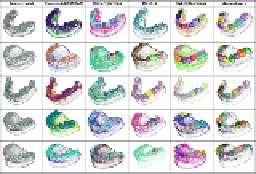Image Processing Reference
In-Depth Information
of the gum and a set of teeth. The methodology is illustrated in
Figure 9
, and the results ob-
FIGURE 10
Results obtained by applying different segmentation techniques to five dental
models.
5 Comments and Discussions
Figure 10
shows the result of applying segmentation methods to five dental casts. The irst
column contains the point cloud of dental models one to five. The second column shows the
segmentation using RANSAC algorithm. There is a noticeable difference in the results for
model three in comparison to the other four, mainly due to teeth unevenness.
The third column presents the result of the Region Growing segmentation, where restric-
tions of smoothness given by the curvature and the angle between the normal are used.
The fourth column corresponds to Min-Cut-based segmentation, which separates the tooth
built requiring human interaction in selecting a landmark for each tooth. As a consequence
of this, the fifth column shows a methodology where landmarks are automatically selected
through NARF, and then segmented using Min-Cut. Finally, the sixth column shows the
Ground truth, built manually using Mesh Lab.
Results of teeth segmentation using the proposed methodology seem appropriate in appear-
ance; however, they must be subject to analysis carried by experts in order to qualify them.
6 Conclusion
Dental casts contain rich information in terms of curvature and geometry, comprising semi-
lat zones, highly curved zones, objects of interest with variable sizes, etc. As it happened with
problem that proved to be tackled in a more comprehensive manner through the means of a
mixed methodology, composed by various well-known techniques that can be further tuned
to recognize or separate a particular structure.
From this work, some achievements can be highlighted:
• Segmentation of the gum and teeth can be carried out adequately using the Region Grow-
ing algorithm based on the curvature and the angle between the normal vectors.
• The potential for Min-Cut algorithm for segmenting each tooth is evidenced.
• It is possible to apply the proposed methodology using NARF and Min-Cut, obtaining
acceptable results for segmentation while reducing human interaction in seting internal
parameters of the Min-Cut algorithm (landmark selection).
• Automatic radii selection for Min-Cut remains an open issue.

Search WWH ::

Custom Search